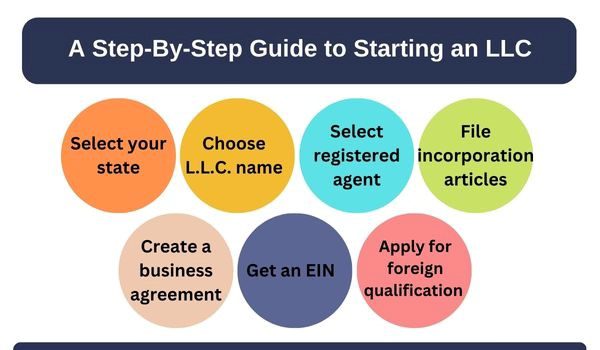Many U.S. business owners use LLCs to run their companies because of the flexible management structure and significant tax benefits associated with this type of business. An LLC company is also less expensive to set up and run than a corporation. Unlike corporations, LLCs are not legally required to appoint directors, form boards, or hold periodic shareholder meetings. Without these administrative requirements, you can concentrate on expanding your business rather than attending mandatory meetings.
Luckily, to form an LLC in a specific state, you do not need to live, conduct business there, or be a U.S. citizen. You can be in any of the 50 states! But what steps do you need to follow to form your LLC? Let’s find out!
1. Select your state.
Choosing a suitable state to form an LLC is critical because it can affect the total costs of forming an LLC. Every state in the United States has the authority to impose different fees on future LLC members. You must understand different company naming requirements in different states before proceeding.
2. Select a name for your LLC.
Most people think about how their current and potential customers will react when they see or hear the name of their new LLC. While selecting the appropriate business name for branding purposes is critical, you must also ensure that the LLC name complies with state requirements. You cannot, for example, choose a business name already used by another company in your state. Check with the Secretary of State in your state or the state where you intend to register your LLC to look up existing registrations. This helps to ensure the business name you want isn’t already used in your state.
You can always change the name of your LLC later. You are not required to use your registered legal name when conducting business. By filing a “doing business as” (DBA) certificate, you can form your LLC under one name but run it under a separate “trade” or “assumed” name. You must also comply with the following requirements:
- You must include “LLC” or “Limited Liability Company.”
- The name must not be an acronym used by a government agency (FBI, IRS, etc.).
If the LLC name you’ve chosen is available, but you’re not going to file your LLC documents immediately, you might want to reserve it. Almost every state allows you to reserve a name by filling out a form and paying a fee. State by state, the length of the reservation period, filing fees, and renewal policies differ.
3. Select a registered agent.
Every state mandates that LLCs have a registered agent. A registered agent receives official or legal documents on behalf of the LLC (e.g., subpoenas). When these documents are received, the registered agent forwards them to the LLC. Anyone over 18 can be a registered agent, and you can name yourself or an employee. However, the agent must be available during normal business hours at a location within your state. You can also name a company that serves as a registered agent.
4. File your incorporation articles.
Each state has its LLC formation forms and procedures. Your incorporation articles may include the following information:
- The company’s name and address
- The duration of its existence, if not eternity
- The reason behind the LLC’s formation
- the registered agent’s name and address
The paperwork is typically signed by the person forming the LLC and the registered agent in some states. In most states, you’ll file LLC formation documents with the secretary of state. In Wyoming, you will be charged a fee of $100.
5. Create a business agreement.
An LLC operating agreement is a road map that outlines how your LLC will operate. It specifies;
- The members’ ownership interests and voting rights
- How profits and losses will be allocated
- How meetings will be held
- How the business will be governed
- The members’ rights if one of them dies or leaves the business,
- How the company will be dissolved if it ceases operations.
The operating agreement is not usually filed with the state and may not be required by the laws of your state. However, it is necessary for business owners to define their rights and responsibilities to avoid future conflicts.
The following are common items found in most LLC operating agreements:
- Each member has financial obligations
- How profits should be distributed and losses are absorbed
- Organizational structure
- Procedure for voting
- Roles of management
- The processes of dissolution
6. Get an Employee Identification Number (EIN).
Following the formation of the LLC, you must get your employer identification number (EIN) from the IRS. Federal Tax Identification Number (FTIN) and Federal Employer Identification Number (FEIN) are other terms for EIN (FEIN). You cannot open a business bank account or hire employees unless you obtain your EIN.
You can get your EIN for free by visiting the IRS website and filling out an online application form. Because the IRS requires the date of business formation to issue an EIN, you should form your LLC first.
7. Apply your foreign qualification (if necessary)
If your LLC conducts business in more than one state, you may be required to register in each state. Since different states have different requirements, you should consult an experienced business attorney to see if you need to register your LLC in multiple states. You need to submit your certificate of good standing (from the state where you first registered your LLC) and paperwork similar to the one you used to form your LLC. You must also designate a registered agent in each state where you register your LLC.
Final Thoughts
Starting an LLC can be both daunting and exciting. Ensuring everything is in order is critical. It’s wise to research your state’s specific guidelines and requirements before filing. We hope this step-by-step guide clarifies the process of forming an LLC in simple steps. For more information, visit this recommended resource for more about creating an LLC.



































